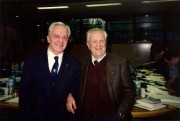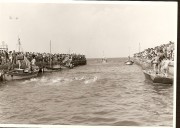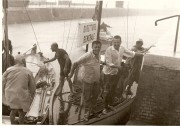Sport Organiser
A Man's First Attempts
|
As Cafiero wrote, Ferraro used to assemble reports on his "first attempts" in each sport activity that was in some way related to the sea. His infinite love for the sea and for those activities in which he is centre stage certainly motivated him, but in order to achieve his targets he needed certain qualities and characteristics. And Ferraro had at least two gifts that were out of the ordinary. A particular sensitivity towards personality traits, which allowed him to understand and make himself understood and limitless energy, which he used to carry out enormous amounts of work at impressive speed. This does not only refer to work related to his profession with Cressi and Technisub but to all work required to take part in meetings, hold conferences, think of new activities, resolve problems and mediate between opposing demands. |
U.S.S. "Dario Gonzatti"
|
The "Unione Sportivi Subacquei Dario Gonzatti" is exclusively recognised as the first Italian diving association. Luigi Ferraro was one of its founding fathers and its President for many years. On May 15th 1948, Ferraro was on his way to work when he met two or three friends who were busy discussing, once again, the disputed question of establishing a diving association. A meeting was arranged that same evening at the Cressi offices. It was attended by Luigi Stuart Tovini, who was born in Florence but was a naturalised citizen of Genoa and who, the following year, won the Italian pre-championship of underwater fishing. Also attending were Gianni Fioroni, a famous optician who, in subsequent years, built the most beautiful private aquarium in the world in his lovely house standing sheer above the sea and Aldo Gasco, a dentist who discovered a wonderful coastal area in Sardinia, where he bought some land and built an unpretentious house. Many years later, that coast became the popular Costa Smeralda and Gasco had to refuse a blank cheque from Aga Khan, who needed that last portion of land to own the whole area, land that Gasco defined as the most beautiful spot of the Coast. Duilio Marcante, one of Egidio Cressi's first collaborators (who, among other things, was able to roll rifle springs in his hands), started working by the sea very early, rising from the ranks of lifeguard and trawler fisherman. But even then, he distinguished himself from his colleagues because he used to dive, as all professional fishermen never swam in the sea, even though he did not use a mask or fins, as they had not yet been invented. |
F.I.P.S.A.S. (Italian Angling and Diving Activities Federation)
|
Ferraro contacted the Italian Angling Federation in 1948, in order to organise the emerging activities from a sports point of view, which at the time mainly involved underwater hunting. Carlo Manstretta, the current Federation's Secretary replied enthusiastically to Ferraro's requests, and in 1949 underwater activities became part of the FIPS (the Italian Angling Federation). |
C.M.A.S.
Finswimming
|
In 1951, when the only fins available were those with straps that hurt your heels terribly, Ferraro organised the first fin-swimming competition in the sea. This involved crossing the coast off Genoa from the Lido to Nervi in four legs, with the last leg taking place at night. Each participant had a waterproof electric torch attached to their rubber cap and the finishing line was a sea cliff that was entirely lit by fire fighters' floodlights. |
|
Underwater Orienteering
|
Even before organising Fin-swimming competitions, Ferraro invented another speciality, known as Underwater Orienteering, in which the athlete, in addition to swimming, needed to be able to use a compass. In 1949, the first competition of this kind took place in Genoa: this involved departing from land, wearing a rebreather 7 meters below the water level, following an itinerary that consisted of three different directions and then returning to the starting point. The experience Ferraro gained as a member of the X Mas Group, during his swimming lessons and underwater orienteering, obviously played a significant role. |
Breath-holding and Freediving Records
|
In 1952, the first breath holding competition in history took place. The contest is known as static breath holding as it takes place in a type of large aquarium. This is a pool with a glass front and the other sides made of sheet steel, measuring 2.50x2.50x3.00 metres, specifically built for the occasion on the Acquasola esplanade in Genoa. "It is a mistake to believe that these records exist for their own sake and that they do not have any use. The underwater world is still to be discovered. Anything that is done to improve our knowledge of it speeds up its conquest. It has been proven that the continental shelf is the only opportunity that humans have left to expand and represents the only solution to future problems relating to hunger and thirst that derive from the increase of world population. |
Spearfishing Competitions
|
Prof. Azzali, in his introduction to the book “Libro bianco – Le Gare di Pesca in Apnea”: writes: And, once again, Ferraro was the inspirational driving force for underwater hunting by writing regulations and organising competitions. Defending Spearfishing and the relevant competitions was another battle in which Ferraro has always been involved, especially within the CMAS. In fact, it was this organisation that should have been responsible for protecting this activity rather than attempting to oppose to it or even abolish it, on several occasions. This is how Ferraro, in the 70s, backed his position. THE BENEFITS OF SPEARFISHING–by Luigi Ferraro"It has been some time now since we started hearing influential rumours and since proposals have been presented against spearfishing. But it was in Ferraro's nature to maintain balance and clarity. If on the one hand he opposed clichés against hunting, from as early as 1951 he did not forget to put in a word for the dreaded sharks. This is what he writes to deny false beliefs. "Man believed that the world stopped at Gibraltar for many years and that earth did not move, so it is not unusual that something that is universally believed is subsequently replaced by a completely different reality. Firstly I would like to be clear on one point: my intention is to eradicate the common belief that sharks are immensely ferocious and courageous animals, which would attack anyone who falls within their reach without discrimination, including humans. I do not believe these assumptions and I intend to demonstrate that they are unfounded with facts. I would like to specify that I am referring to the few notorious anthropophagous species and not to the infinite kinds that feed mainly on fish. If someone asked me whether sharks eat humans or not, I would give them two answers: yes, if the man appears as bait or as prey, if he seems to be in a disadvantaged condition (a man who is swimming on the surface , who is escaping, who lacks energy or sense, a corpse). And no, if the man maintains his own initiative or, especially if he appears in his element. In this situation the shark is forced to consider its options, which he does with the inborn wariness of any animal and with the fear deriving from the unusual encounter. As you will read below, today there are tens of divers who could testify in defence of the poor animal that is accused!" |
Panathlon
|
Panathlon International is an association, which aims to affirm the sport ideal, its cultural and moral values as a means to train and improve humans and to promote solidarity between people and countries. The word "Panathlon" derives from Greek and can be translated with the expression "collection of sporting activities". Present in Italy and in the main Countries across the world, it was set up in Venice on June 12th 1951. After Venice and Brescia, a third Panathlon Club was established in Genoa on May 21st 1952. |



